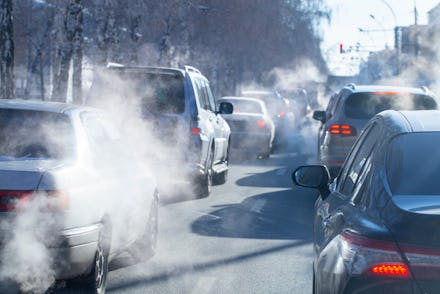Coronavirus is making the skies cleaner — at least temporarily

For weeks, millions of people around the world have been sheltering in place, working from home rather than commuting, and generally upending their everyday habits as they try to curb the spread of coronavirus. Some of those changes to routine have started to change the environment, as well — in the short term, at least. Pollution maps, along with satellite pictures taken by NASA from cities experiencing area-wide quarantines, show that the air is starting to get clearer.
Perhaps nowhere are the effects more stark than in China, particularly in the usually-bustling regions surrounding Beijing, Shanghai, and Wuhan. According to NASA's monitoring tools, the far eastern sector of the country has seen a "significant decrease" in the concentration of nitrogen dioxide (NO2) in the air. The gas is typically pumped into the atmosphere by burning fuel from things like cars, buses, and even power plants. From January 1 to February 25, researchers at NASA saw the harmful emissions largely clear out. The agency noted that there is typically a downturn in pollution around this time, but the change experienced this year was far more than usual. “This is the first time I have seen such a dramatic drop-off over such a wide area for a specific event,” Fei Liu, an air quality researcher at NASA’s Goddard Space Flight Center, said in a statement.
NASA chalked up the changes to the "economic slowdown" that has been caused by the coronavirus, including a mass quarantine that pressed millions of people to stay home for an extended period of time. As many as 56 million Chinese citizens were required to isolate themselves starting in late January — including a nearly complete lockdown of Wuhan's more than 11 million residents, who were effectively cut off from the rest of the world for two months.
During the shutdown, almost all stores in Wuhan were closed — save for those selling food and medicine. Private vehicles were banned from operating on the city's streets without permission. Public transit was halted entirely. The results were not always positive. Vulnerable populations were left without access to food and other essentials, and it's believed that at least one person died as a result of being cut off from care and necessary services. But the drastic and draconian method did manage to stop the spread of the disease — and appears to have cleared up the air surrounding Wuhan. The city that just one year ago was host to a massive protest over air pollution has seen one of the biggest short term improvements in air quality that NASA has recorded.
It's possible that these improvements in air quality have saved lives in China. According to research published by Marshall Burke, an assistant professor of earth system science at Stanford University, pollution that would typically be clouding the air would kill as many as 77,000 people over the course of two months. But the reduction in air pollution "likely has saved the lives of 4,000 kids under five and 73,000 adults over 70 in China," according to Burke.
While China might be ahead of the curve because of how long it has been dealing with coronavirus, it is certainly not alone in seeing this reduction in pollution. Italy imposed a nationwide quarantine on March 9 in order to halt the spread of COVID-19. With millions of Italians told to shelter in place and not leave their home unless absolutely necessary, the country has started to experience a significant reduction in air pollution. No place is it more apparent than in northern Italy, where as many as 16 million people face strict travel restrictions and potential ramifications for breaking quarantine. Images collected by the European Space Agency (ESA) show pollution in the region dissipating as much of the nitrogen dioxide that would normally be emitted by millions of cars on the street is nowhere to be found.
The situation is still developing in the United States, where few regions have gone so far as to implement a strict shelter in place policy that restricts travel. San Francisco became the first major city to issue such an order and was soon joined by Los Angeles. California Governor Gavin Newsom recently announced a state-wide requirement that all of California's 40 million citizens stay home, and New York governor Andrew Cuomo followed suit with a similar order for New York state's nearly 20 million people. It's too early to see the pollution clear out as evidently as it has in other regions, but cities and states that decide to enforce strict quarantines are likely to see an improvement to air quality. Transit data from transportation technology firm TomTom suggested that New York City has already seen a significant decrease in traffic congestion, down to just 17 percent from as high as 52 percent during the same period in 2019. That drop off in traffic comes with a decrease in air pollution, as fewer cars means less emissions
These changes are positive ones, particularly for the health of the general public. Air pollution — especially from fossil fuels — can result in all sorts of health complications including depression and can ultimately lead to death for vulnerable populations. But the improvement in air quality is also likely to be only temporary. When quarantines have been lifted and people return to their lives as they were before the coronavirus outbreak, pollution from transportation will return. The reprieve from pollution will likely be brief, but it's a good indicator of just how quickly we could turn things around and address concerns related to climate change if we just took it as seriously as we're taking this pandemic.